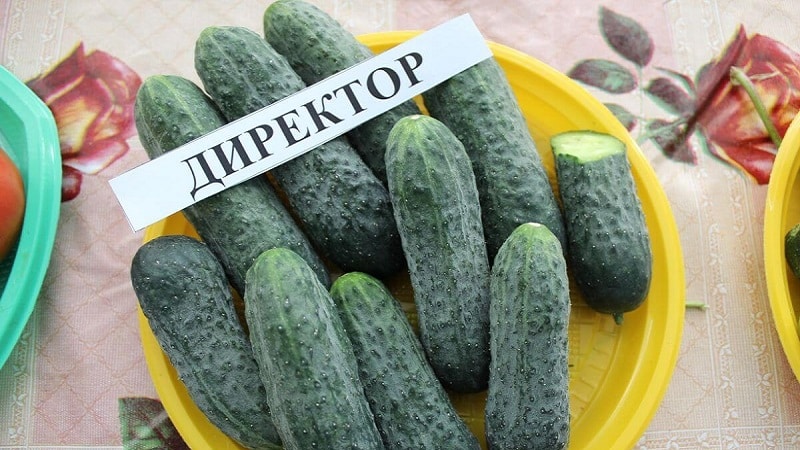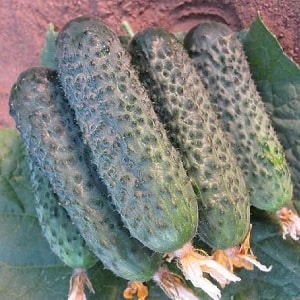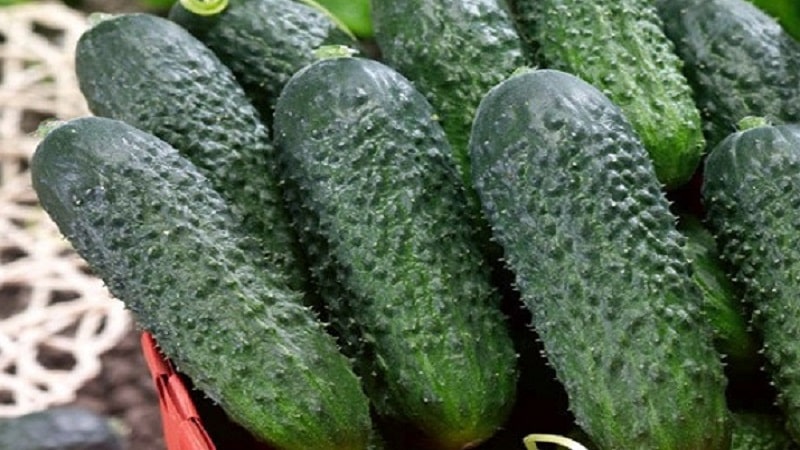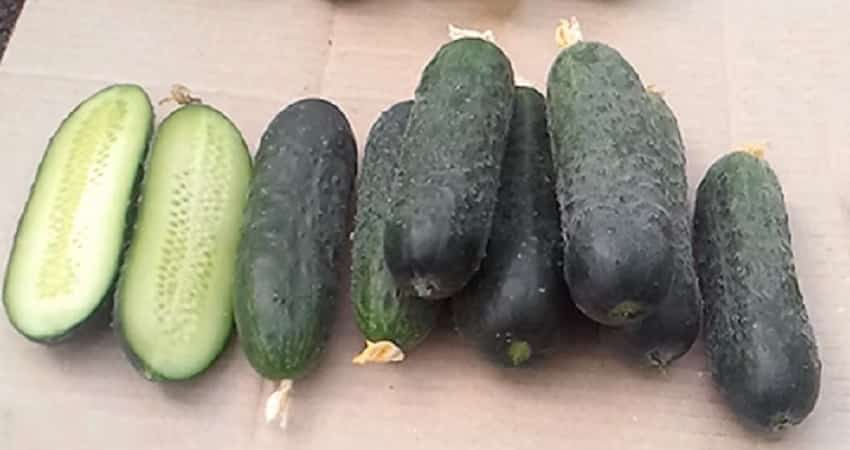Dutch cucumber “Director” with long shelf life and stable yield
Cucumbers are one of the most beloved crops by gardeners. Among the variety of these vegetables, Dutch hybrids occupy a special place. Their prominent representative is the Director of F1. Included in the State Register of Plants of the Russian Federation in 2013, after several years of cultivation it became popular among gardeners. The fruits have an excellent taste and the hybrid is unpretentious in care. However, only by observing the entire range of agrotechnical measures will you get maximum yields.
Description of cucumbers
Director F1 is the result of development by Dutch breeders Nunems company. Scientists have bred a hybrid from the parent lines “Hector” and “Merengue”.
Reference! The hybrid is parthenocarpic, that is, a high yield will be obtained without the participation of pollinating insects. There are practically no empty flowers on the stems; most of the flowers are of the female type.

Distinctive features
Hybrid bears fruit already by 40–45 days after the appearance of the first shoots. Experienced farmers manage to grow crops twice per season.
Director F1 has an average stem length, therefore well suited for growing in greenhouses. There is no need to worry that the ovaries will not form and the plant will be overly thickened.
Hybrid resistant to typical crop diseases, therefore, when cultivating this vegetable, intensive use of chemicals for pest control will not be required.
Composition, properties, benefits and calorie content
95% of cucumbers are structured water, which is beneficial for human health.The vegetable cleanses the kidneys well, removes toxins, heavy metal salts and waste.
Among the vitamins and microelements cucumbers contain:
 vitamins A, group B, C, PP;
vitamins A, group B, C, PP;- beta-carotene;
- potassium;
- folic acid;
- chromium;
- magnesium;
- iodine;
- phosphorus;
- iron;
- zinc;
- manganese;
- sodium;
- copper.
Fiber gently stimulates intestinal function. Positive properties also include the ability to remove salts from joints, prevent the appearance of cholesterol plaques, and improve blood properties.
Attention! Cucumbers are low in calories: 100 g contain only 15 calories. They are perfect for dietary nutrition.
Characteristics
The plant is highly branched, medium-sized. The hybrid bush has well-developed side shoots. They form 2-3 ovaries in each node. All ovaries pass along the main stem. The hybrid has many leaves, they are dark green in color and medium in size.
The fruits are small: up to 12 cm in length. Cucumbers weigh approximately 80 g, have a regular cylindrical shape, and are covered with a dense, smooth dark green peel.
Important! The pulp of cucumbers is aromatic and juicy, without any bitterness. The seeds inside are small and almost unnoticeable when eaten.
The fruits do not turn yellow and do not overgrow, the shape is almost perfect for all cucumbers. They tolerate transportation well without losing their taste. In a cool room they can be stored for up to a week without losing their appearance.
The hybrid has Director F1 excellent yield indicators: with proper agricultural technology you can get from 20 to 25 kg of cucumbers from 1 bush.
Other Dutch for your site:
How to grow your own
Planting and caring for the Director F1 hybrid is no different from caring for any other variety of cucumbers.
Before sowing, prepare the beds: in the fall, remove all plant remains, dig up and fertilize the soil. In the spring, the soil is disinfected with a hot solution of potassium permanganate, then dug shallowly again.

There are two ways to grow Director F1: seed or seedling. Let's look at each of them in turn.
Planting by seeds and seedlings
When choosing a seed growing method seeds are sown both dry and soaked, waiting for the peck. The seeds are deepened into holes 2 cm deep. Place two seeds in one hole. From sprouted specimens in the phase of the first true leaf, the weaker seedling is pinched off.
Important! Seeds are sown when the soil warms up to +14°C.
To get the highest possible yield It is worth planting cucumbers at the rate of no more than 3 plants per 1 square meter. m. Only then will the plants be able to develop fully, giving an excellent harvest.
Reference! Director F1 grows well after legumes (excluding beans), cabbage, potatoes and onions.
 The seedling method allows you to get the harvest a couple of weeks earlier than sowing directly into the ground. Purchased seeds do not require additional treatment with growth stimulants or disinfection.
The seedling method allows you to get the harvest a couple of weeks earlier than sowing directly into the ground. Purchased seeds do not require additional treatment with growth stimulants or disinfection.
You can buy soil for planting or make a mixture yourself. To do this, mix turf and humus in equal proportions. Add about half a glass of ash, 5 g of potassium sulfate, and 10 g of superphosphate to a bucket of soil. The soil is then calcined for disinfection.
It is advisable to use special individual containers for planting - the crop does not like picking.Peat tablets, cups, or any other small container of suitable size will do.
Important! Before use, the container is disinfected and dried. The product "Extrasol-55" is suitable.
The containers are filled with the prepared mixture, retreating about 1 cm from the side. The soil is slightly compacted and moistened. Seeds are placed in holes 2 cm deep. In order for the seeds to hatch faster, the seedlings are provided with a constant temperature in the range from +22°C to +26°C.
After the first true leaf appears, the seedlings are fed, for example, with Kemira-Lux or Radifarm fertilizer. As soon as 4 leaves are formed on the plant, the bush can be transplanted into open ground.
Growing and care
Plant the crop, keeping 30 cm between plants, and between the rows - about 1 m. The seedlings are placed in a checkerboard pattern.
Further care consists of regular watering, fertilizing and bush formation. Water the cucumbers at the very root with warm, settled water. In open ground, the watering schedule is daily, in a greenhouse - as the soil dries out.

Feeding is important for a hybrid. They are held once every two weeks. Chicken manure or manure works great. Urea, ammonium nitrate or superphosphate are also used. In addition to root feeding, the Director hybrid also requires treatment of leaves with mineral fertilizers.
For Director F1 it is important to form the bush correctly. The plant is pinched off the main vine after 8 or 9 leaves have formed on it. The procedure must be carried out at least once a week.
Important! As the canes form in the greenhouse, they should be attached to a trellis or other support.
Features of cultivation and possible difficulties
Among the features of the hybrid are noted:
- The need for regular feeding, which has a positive effect on the growth and development of the vegetable.
- The F1 director requires mandatory and regular stepsoning. Otherwise, you may not have a good harvest.
- It is recommended to pinch the vines: removing the top of the fruiting plant improves the nutrition of cucumbers and speeds up the ripening period of the fruit. The procedure is carried out on the eighth leaf, and the side shoots and tendrils are removed.
- The hybrid has strong immunity, so you don’t have to use fungicides.
- When growing in a greenhouse, it is important to ventilate it regularly, while avoiding drafts and sudden temperature changes.
Diseases and pests
Director F1 is resistant to many diseases. Among them:
- mosaic;
- powdery mildew;
- brown spot.
However the hybrid is damaged by such a common disease as white mold (sclerotinia). First, “sputum” appears on the plant, which gradually turns into a white coating. Then the cucumbers become covered with tuberous growths, and the stem itself gradually softens. As a result, the plant dries out and the fruits become flabby.
To deal with white mold, all damaged parts are removed. The remaining vines of the plant are treated with a medicinal solution: 1 g of copper sulfate and 5 g of urea are used for 5 liters of water. The medicine is used at the rate of 0.5 liters per 5 square meters. m landings.
Attention! Sclerotinia is easier to prevent than to treat. Among the preventive measures, the most effective is adding coal and ash to the soil. During the process of growing a hybrid, you can sprinkle the soil with them.
To prevent diseases, spraying is carried out cucumbers with the preparations “Previkur”, “Abiga-pik”, copper oxychloride.These remedies can not only cope with the disease, but also make the fruits more resilient and stronger.

Harvesting and application
To obtain constant and long-term fruiting, cucumbers are harvested daily or every other day. It is best to harvest early in the morning or late in the evening, as it is believed that the fruits are most resilient during these periods. Freshly picked cucumbers are placed in a cool place.
Reference! It is best to cut cucumbers with a garden tool rather than pick them by hand. This is necessary so as not to damage the plant’s vines.
The yield of the hybrid is excellent, so there will be a lot of fruits. In addition to fresh consumption, Director cucumbers are suitable for a variety of winter preparations.
Advantages and disadvantages
Among the advantages of the hybrid are the following::
 A powerful and medium-sized bush that does not require complex care.
A powerful and medium-sized bush that does not require complex care.- Great taste of cucumbers.
- Excellent transportability, the fruits do not lose their appearance or taste.
- Long-lasting fruiting compared to other cucumbers.
- Possibility to grow a hybrid twice per season.
- Tolerant to growing in the shade, giving the gardener more options for planting beds.
- Equally good harvest on different types of soil.
- Excellent regeneration abilities: the plant can easily recover from damage.
The disadvantages of the F1 Director include:
- The need to regularly remove a large number of stepsons. This procedure takes time, but it promotes the development of the plant and affects the harvest.
- Inability to collect hybrid seeds for the next season.
- Relatively high price for seeds compared to varietal cucumbers.
Read also:
Reviews
Summer residents with experience choose a hybrid for early ripeness, endurance and high yield. We bring to your attention reviews from those who have already cultivated the Dutch Director.
Tatyana, Novorossiysk: “I planted Director F1 after reading positive reviews about it and seeing photos of the harvest. I have long wanted to grow cucumbers without bitterness. I'm happy with the result, although probably due to the fact that I didn't plant regularly, the harvest was less than expected. However, this did not affect the taste in any way.".

Maria, Krasnodar: “I tried to plant the hybrid Director F1 in my dacha. I was captivated by the description of the variety - very early. I sowed it on July 1, and by August 1, cucumbers had already appeared. A week later there were already a lot of them. The fruits taste good, the yield is high".
Anton, Svetlograd: “An excellent option for those who grow cucumbers for sale. Of the many options I have tested, Director F1, subject to all agrotechnical measures, yields up to 30 kg per bush. The fruits are excellent and store just fine. During transportation, they almost do not lose their presentation, which is important for farmers. I recommend it to everyone for commercial cultivation".
Conclusion
Director F1 is an excellent hybrid that produces a bountiful harvest with little effort. But do not forget to plant the bush and fertilize it in a timely manner.
Since the hybrid, with the right agricultural technology, allows you to grow two crops per season, and caring for it is not at all difficult, it is quite possible to have fresh green vegetables on your table from early spring to late autumn.